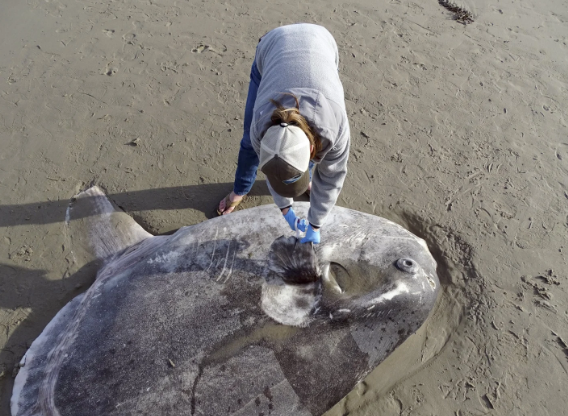
©Thomas Turner, UC Santa Barbara via AP
Pre-reading questions:
- Have you ever heard of sea creatures washing ashore on beaches? What do you think causes this to happen?
- Why is it important for scientists to study rare species of animals and fish?
Vocabulary:
- identify /ahy-DEN-tuh-fahy/
- species /SPEE-sheez/
- discovery /dih-SKUHV-uh-ree/
- specialist /SPESH-uh-list/
- detailed /dih-TEYLD/
[verb] – to recognize or be able to name someone or something, or to prove who or what someone or something is
The teacher helped the students identify different types of plants in the garden.
[noun] – a set of animals or plants in which the members have similar characteristics to each other and can breed with each other
There are many species of birds in the forest near our school.
[noun] – the process of finding information, a place, or an object, especially for the first time, or the thing that is found
The discovery of an old shipwreck was very exciting for the archaeologists.
[noun] – someone who has a lot of experience, knowledge, or skill in a particular subject
The specialist knew a lot about marine animals and helped identify the rare fish.
[adjective] – including a lot of information
The teacher gave a detailed explanation of the science experiment.
Article reading:
Despite initial doubts due to unclear photos and the unusual location of the fish, Nyegaard provided detailed instructions for additional photographs and tissue samples. Turner and Nielsen located the fish, moved by the tide, and took the required photos. Based on these clearer images, Nyegaard confirmed the identification. Hoodwinker sunfish are flat, oval-shaped with wing-like fins. The measured fish was over 7 feet long, 227 centimeters wide from fin tip to fin tip, and had a dorsal fin length of about 2.5 feet (75 centimeters). Its weight was not recorded. This discovery is significant as it marks a rare appearance of this species in the Northern Hemisphere.
Comprehension questions
- Where was the large sea creature found, and what was its size?
- Who first discovered the sea creature, and what did they initially think it was?
- How did the identification of the creature gain attention, and who ultimately confirmed its identity?
- What were the distinguishing features of the hoodwinker sunfish mentioned in the article?
- Why was the discovery of the hoodwinker sunfish in Southern California significant?
Discussion questions
- Have you ever encountered an unusual animal or creature in your area? If so, could you describe the experience? If not, what would you do if you found a rare species washed ashore?
- Do you think interns and students play a crucial role in scientific discoveries like the one described in the article? If so, why? If not, what other factors do you believe contribute to such discoveries?
- Do you agree that social media platforms can play a vital role in spreading awareness about rare discoveries like the hoodwinker sunfish?
- Considering the significance of the hoodwinker sunfish’s discovery in the Northern Hemisphere, what potential impacts might this have on marine biology research and conservation efforts?
- Reflecting on the collaborative effort described in the article, how do you think the process of identifying rare species could be improved or streamlined in the future? What challenges might arise in this process, and how could they be addressed?